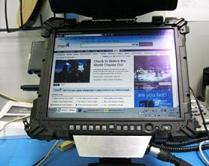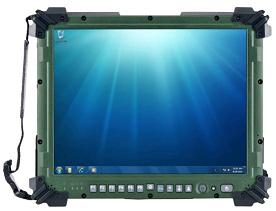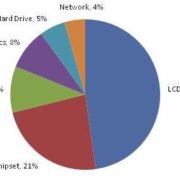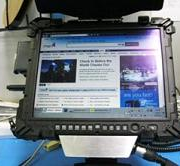Smartphone vs. Tablet vs. PDA
For many IT managers and other personnel responsible for enterprise procurement, smartphones were a cheap, popular way of dipping their toes into the pool of mobile technology. However, it’s becoming obvious that smartphones are not appropriate for many enterprise applications. So why second thoughts?
 Supposedly, a high number of people call a repair man to fix their television, when all they really need to do is plug it in. Similarly, most actions for maximizing the life of a battery for a mobile computer may be characterized as excessively obvious. Here is a list to help you “remember the obvious.”
Supposedly, a high number of people call a repair man to fix their television, when all they really need to do is plug it in. Similarly, most actions for maximizing the life of a battery for a mobile computer may be characterized as excessively obvious. Here is a list to help you “remember the obvious.”
1) Avoid unnecessary applications. Especially those that constantly run in the background. One expert suggested going as far as to uninstall them. We all know this instinctually, but how often do you actually check this? Even if you think you there is nothing unnecessary on your computer, take time out every once in a while and examine exactly what applications are running. Read more
 AMREL customizes a lot of computers. Sometimes, the customization is almost a complete build-to-order. Other times, it’s as simple as adding a connector to a laptop or tablet. Actually, adding a connector isn’t so simple. Consider the conventional way of adding a connector to a mobile computer:
AMREL customizes a lot of computers. Sometimes, the customization is almost a complete build-to-order. Other times, it’s as simple as adding a connector to a laptop or tablet. Actually, adding a connector isn’t so simple. Consider the conventional way of adding a connector to a mobile computer:
- First space must be found to accommodate the connector
- A hole and mount points must be machined into case wall
- Power and signal wires must be soldered to mainboard and routed to backside of the connector
- Finally, the laptop or tablet is reassembled and tested Read more

Videos of computers being smashed have a certain visceral appeal. Even though computers make our life easier, all of us have experienced an impulse to chuck one through a window.
While not quite as violent as a window toss, this video demonstrates a test that seems eerily familiar to a drop test of MIL-STD 810.
 It may be hard to remember all the way back to 2010, but when the iPad was first introduced, no one was sure if the public would actually adopt it. “People already have a smartphone and a laptop,” ran a common refrain, “What’s the point of another mobile form factor?”
It may be hard to remember all the way back to 2010, but when the iPad was first introduced, no one was sure if the public would actually adopt it. “People already have a smartphone and a laptop,” ran a common refrain, “What’s the point of another mobile form factor?”
 Are keyboards dead? In view of their ubiquity, and proven usefulness, this may seem to be an absurd question, but some people are considering this possibility. The success of the keyboard-less iPad in penetrating the business market was one of 2011’s big surprises. Also, in an interview in the IEEE Spectrum, journalist Sally Wiener-Grotta noted the impressive number of stylus interfaces on display at the recent Consumer Electronics Show (CES). She even cites studies that claim that when we use handwriting input, “… we absorb information better and we express information better…” Read more
Are keyboards dead? In view of their ubiquity, and proven usefulness, this may seem to be an absurd question, but some people are considering this possibility. The success of the keyboard-less iPad in penetrating the business market was one of 2011’s big surprises. Also, in an interview in the IEEE Spectrum, journalist Sally Wiener-Grotta noted the impressive number of stylus interfaces on display at the recent Consumer Electronics Show (CES). She even cites studies that claim that when we use handwriting input, “… we absorb information better and we express information better…” Read more
 The Department of Defense’s (DoD) ambitious smartphone program may or may not reach its goal of providing advanced mobile communication devices to the warfighter, but it certainly has already scored one noteworthy achievement: creating stories for journalists. At last count, Google News has 300+ entries for “military smartphone.” Most of these stories report that the single biggest obstacle to smartphones deployment is security. Read more
The Department of Defense’s (DoD) ambitious smartphone program may or may not reach its goal of providing advanced mobile communication devices to the warfighter, but it certainly has already scored one noteworthy achievement: creating stories for journalists. At last count, Google News has 300+ entries for “military smartphone.” Most of these stories report that the single biggest obstacle to smartphones deployment is security. Read more
The initial purchase price of your rugged computer may only be a small part of the Total Cost of Ownership (TCO). Platform support, customization, integration, connectivity, and inadequate durability may make your “bargain” very expensive. Will your rugged computer be good for your ROI five or ten years from now or just for today?
small part of the Total Cost of Ownership (TCO). Platform support, customization, integration, connectivity, and inadequate durability may make your “bargain” very expensive. Will your rugged computer be good for your ROI five or ten years from now or just for today?
Commercial Off the Shelf (COTS) products are attractive for the price and established supply chain. However, there is a fundamental problem buying mass-produced off-the-shelf items. New and upgraded products typically generate more profit than old ones. Corporations prioritize the overhead of product support for the greatest revenue earners, i.e. the new products. Support for older platforms is phased out. Read more
 Richard Lane, AMREL’s VP of Strategic Business Development, penned an interesting article about his rugged computing needs as an environmental scientist when he inspected on-shore /offshore oil production facilities. In the July 2010 issue of Occupational Health & Safety, Richard writes, “Ironically, we probably spent more money on metal clipboards, waterproof paper, copies, and redundant data entry than I spent last week on a new netbook.” Check out Strategic Value for the Health & Safety Industry.”
Richard Lane, AMREL’s VP of Strategic Business Development, penned an interesting article about his rugged computing needs as an environmental scientist when he inspected on-shore /offshore oil production facilities. In the July 2010 issue of Occupational Health & Safety, Richard writes, “Ironically, we probably spent more money on metal clipboards, waterproof paper, copies, and redundant data entry than I spent last week on a new netbook.” Check out Strategic Value for the Health & Safety Industry.”
In a recent posting (Network-centric Warfare: Dead or Alive ?), I wrote about the debate concerning network-centric warfare. In the wake of the “reorganization” and outright elimination of high-profile initiatives and programs associated with network-centric warfare, Defense vendors are anxiously wondering if it  will persist as a central doctrine for transforming the military.
will persist as a central doctrine for transforming the military.
Clearly, the military’s obsession with connectivity is far from over. DARPA is actively working to overcome the military’s traditional anxiety about the security of distributed servers (Pentagon Looks to Militarize the Cloud). The Army is running a contest for mobile applications and talking about issuing smartphones to every soldier (A Smart Phone for Every Soldier?). Solutions are being displayed for sticking 3G cellular pods on a variety of vehicles, including UAVs (Forward Airborne Secure Transmissions and Communications).
So the forces that spawned network-centric warfare are still active, but as I concluded in the above-referenced blog post, so are the problems that have frustrated its implementation. Here’s a partial list of obstacles
- Money
- Lack of interoperability
- Money
- Development and acquisition pipeline logjam
- Money
According to at least one analysis, the current cost-climate climate means “… that the personnel and procurement budgets will be reduced to pay for O&M costs…” (Defense Industry Daily). As the demand for novel technology grows, acquisition budgets shrink. Defense wants the latest and greatest solutions, they want them now, and they want them to have a TRL level of 9 before they even see them. Government paying for research, testing, validation and verification? That’s so 20th century.
Using mature systems to develop advanced, useful solutions for today’s challenges is not impossible. Working with strategic partners, AMREL has developed System One, a Last Tactical Mile solution, a system composed of entirely battle-proven technology.
“The Last Tactical Mile” is a classic problem of network-centric warfare. Front-line troops are demanding real-time information. The days are over when data for C4ISR (Command, Control, Communications, Computers, Intelligence, Surveillance and Reconnaissance) only went to the “back-end” (headquarters located away from the front). However, getting this information into hands of the warfighter is a tremendous problem.
To appreciate the complexities of “The Last Tactical Mile,” imagine a team of Marines attacking a high value target in littoral waters. They might be deployed on an amphibious assault vehicle (whatever replaces the now-canceled Expeditionary Fighting Vehicle). In theory, this scenario could require connectivity among a UAV, external ship sensors, satellite networks, the amphibious assault vehicle, mother ship personnel, and the strike team deployed. Space is limited aboard the ships and all equipment must be ruggedized in order to withstand the harsh maritime and combat environments.
System One leverages AMREL’s broad range of from-factors for mature computing platforms, which are more than rugged enough to withstand the brutal vibrations of the high-speed landing craft, the corrosive conditions of the sea, as well as the violent realities of warfighting. AMREL’s durable, battle-tested PDAs are ideal for the Marine strike team. AMREL’s portable, rugged tablets could maintain communication with the amphibious assault vehicle’s coxswain as well as the mother ship’s onboard crew. Our fully functional 19/2® servers are1/4 the size of normal rack-mounted units, so they’re perfect for the cramped quarters of the assault vehicle. Designed to be flexible and to maximize connectivity, AMREL’s computers would have no problem tying the whole thing together with a MESH network.
System One has already successfully demonstrated the connectivity and reliability required for such a scenario. It can be installed on any vehicle, land or sea. It would function perfectly in the high-speed Stiletto boat and is small enough to fit in even the most crowded MRAP vehicle. In fact, it’s so compact, it is even man-portable.
An example of an advanced solution using mature, field-tested components, System One demonstrates that with careful strategic teaming and a bit of imagination, diminished government resources for research and testing can be leveraged into an opportunity.
For a more detailed discussion of “The Last Tactical Mile” and System One, please see IDGA’s interview with Luke McKinney, an expert in military intelligence operations and joint mission analysis.
American Reliance, Inc.
789 N Fair Oaks Ave,
Pasadena, CA 91103
Office Hours
Monday-Friday:
8:00 am – 5:00 pm PST
Saturday: Closed
Sunday: Closed
Main: +1 (626) 482-1862
Fax: +1 (626) 226-5716
Email: AskUs@amrel.com
Blog Posts
Mobile Biometric Solutions
Mobile Biometric Smartphones & Tablets
BioFlex S® Commercial Smartphones
BioSense AT80B | 8″ Android Biometric Tablet
BioSense PA5 | 10.1″ (Gen 2) Android Biometric Tablet
BioSense PA5 | 10.1″ Android Biometric Tablet
BIOPTIX PM3B | 7″ Windows Biometric Tablet
BIOPTIX PM5B | 10.1″ Windows Biometric Atom Tablet








